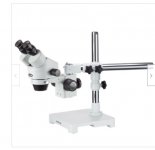ttrager
Cast Iron
- Joined
- Jul 23, 2015
- Location
- East Side / Detroit
The title sums it up.
Our application is the polishing of tooling we make for molding customers. Typically, these are parts .300 to 1.5" in dia in some form of steel or perhaps Moldmax/Moldstar copper alloy.
Surfaces range from basic ODs and Radius to intricate molding surfaces.
We have two polishers who are currently using a basic, binocular type microscope as they dynamically handle the part during polishing.
We are investigating an improvement on that, as the current setup isn't ergonomic over hours worth of having eyes glued to the binocs.
There are digital microscopes out there with output to a flatscreen. But the one's I've seen so far have a fairly large screen sitting to the side of the microscope on the table. This is fine for a static part viewing / measuring. There's no real posture issue tied to real-time part manipulation.
Anyway, any feedback from a shop running polishers using microscopes would be helpful.
Regards
Our application is the polishing of tooling we make for molding customers. Typically, these are parts .300 to 1.5" in dia in some form of steel or perhaps Moldmax/Moldstar copper alloy.
Surfaces range from basic ODs and Radius to intricate molding surfaces.
We have two polishers who are currently using a basic, binocular type microscope as they dynamically handle the part during polishing.
We are investigating an improvement on that, as the current setup isn't ergonomic over hours worth of having eyes glued to the binocs.
There are digital microscopes out there with output to a flatscreen. But the one's I've seen so far have a fairly large screen sitting to the side of the microscope on the table. This is fine for a static part viewing / measuring. There's no real posture issue tied to real-time part manipulation.
Anyway, any feedback from a shop running polishers using microscopes would be helpful.
Regards



